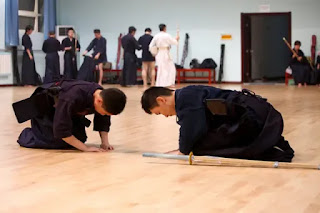by Phillip “Pete” Starr
A few moments spent occupying the conscious mind with a simple, repetitive job can be very beneficial. And this is a central goal of the Dao (Do in Japanese)...such as the Japanese tea ceremony and Chinese/Japanese calligraphy. When the visitor to the tea hut pauses outside to rinse his mouth and hands from the water basin that is always there, it's a moment for him to clear his mind from the distractions of daily life. When the calligrapher sits and rubs his ink stick against the stone well, mixing the ink with water, he is not just preparing his utensils; he is doing the same thing...calming his thoughts and centering himself.
We “count to ten” in the martial Ways as well although few take advantage of the natural opportunities they have to do so when at the training hall. Although survival in the wilderness is a bit different from survival in the training hall, the time you take to prepare yourself for the rigors of training can be vital. This moment occurs with some frequency but it's not announced as a special event. One of the main ones occurs when you pause to bow.
In China, martial arts classes rarely involve bowing. It is my opinion that they should. Some gong-fu schools in the U.S. have adopted this practice, but it's very rarely seen in China. In Japanese martial Ways, the class bow is not simply a courtesy; the minds of the students are brought to a state of refined concentration. Matters outside of the training hall (or class in general) are put on hold temporarily. What matters is the lesson and training, and the direct experience of facing yourself through attacks and defenses against others, and the practice of form.
Beginners, who are still fumbling with the technical details of movement and technique generally lack the ability to make a strong, potentially harmful technique. If one of them strikes his partner, the harm done (if any) is usually quite minimal. More senior practitioners, however, are more serious and their technique is much stronger. They must be very mindful of what they're doing. The advanced student must more and more enter training with a complete grasp of the seriousness involved and the real possibility of hurting someone or being hurt himself. For him, the bowing and other such rituals should have greater significance.
Within the older Japanese martial arts (especially those intended for the battlefield) the rituals are a bit longer and more intense. There is more intensity to the bow that is much deeper and more concentrated than that found in lower levels or arts that were not developed for warfare. These forms of bowing and ritual take some time to learn and appreciate. In some of them (especially those exercises involving a partner) it is common to see the two participants advance and retreat a few steps before or after bowing. The elaborate nature of this kind of etiquette suggests that such rituals are more than merely quaint anachronisms, as many outsiders often suspect.
Rather, they are a dynamic way of preparing the participant mentally and spiritually for the rigors of the exercise that is to follow. They're a way of “counting to ten.” And although most modern martial arts devotees may not ever experience these arts and their accompanying rituals, he/she should strive to adopt a similar serious and focused attitude when preparing for training.
So, what if the practitioner practices a discipline in which the bow is little more than a quick nod and a slap of the thighs with the hands? Well, as I said earlier, the more serious the art and training, the more important is the ritual. If the practitioner is content to emgage in limited endeavors of sparring and dance routines (which are often all that's taught and learned in some schools), he/she has no need of ritual. But if he/she wants to devote him/her self to the study of a serious martial form which demands confronting the essentials of life and death, then it is inevitable that the mental/spiritual preparations he/she will need to make in his/her training will be as intense as those required for surviving mortal combat.

.jpg)




.jpg)
















No comments:
Post a Comment